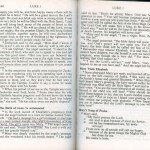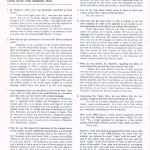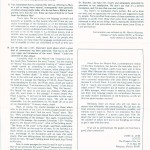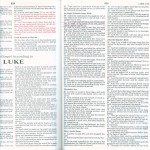By Mary Fairchild
 Schaumburg Christian Women’s Club Luncheon 1990s.
Schaumburg Christian Women’s Club Luncheon 1990s.
-
PSYCHOLOGY AND LARRY CRABB: Christine Narloch Expose
- STONECROFT MINISTRIES
- TEV ERRORS
Stonecroft Ministries is a non-denominational, non-profit Christian organization providing global leadership in women’s ministry. Classic Stonecroft Bible Studies are designed to be used with the TEV Good News New Testament because page numbers are given to make finding the Bible references simple.
With the passing of the original founders of Stonecroft, modernism has begun to creep in. Perhaps unscriptural changes are too subtle to recognize at first and maybe our culture has just become too enamored with the “human personality” to notice the subtle shift from serving the Lord to having “your needs met.” New Christian books, new Bible versions, and the impact of modernism on the Church have blinded many of us to the new terminology and ideology that is based on human wisdom.
Christine Narloch’s expose (click on image to enlarge):
The Bible claims divine revelation as it offers its explanations of why people behave the way they do and how they change. Whether or not you are separated from God or relating with God will affect every attitude, choice, and action you make. Scientifically, we can record external aspects of human nature, but we must turn to the Scriptures for explanations of why people behave the way they do and how they can change.
 Lane Henderson with my family.
Lane Henderson with my family.
For the Christian, everything in our lives is about God’s preparation and process of making us into Christ’s image (Romans 8:28, 29). That’s how and why all things work together for good. It is good for the purpose of perfecting us. He blesses us as we continue to grow. Rather than focusing on problems (needs) or attempting to expose the heart, Christians are to be involved in active sanctification, growing in the fruit of the Spirit, learning to walk according to the Spirit, and with becoming like Jesus. It is only with opposition (problems) that resistance can build up and God desires to develop that strength in us so that we can more effectively fight the good fight of faith and grow strong in the Lord (1 Peter 1:7).
Larry Crabb started up his “New Way Ministries” site in 2001 which was just before I experienced Mindy Caliguire’s introduction as a “spiritual director” at Willow Creek Community Church in South Barrington, Illinois (Protestant No More). During the late 80s the psychology movement was becoming big at Willow Creek Community. I remember they had office rooms set up specifically for the counselors to work at Willow Creek. Larry Crabb is an author, licensed clinical psychologist, and founder and Director of the Institute for Biblical Community which used to be the Institute of Biblical Counseling at Colorado Christian University in Morrison, Colorado, where he is also Distinguished Scholar in Residence. The Institute for Biblical Community has been replaced with his School of Spiritual Direction & SoulCare.
 Friendship Bible Coffee with Lane Henderson in my home.
Friendship Bible Coffee with Lane Henderson in my home.
In 1974 Stonecroft made an attempt in their newsletter (below; click to enlarge) to address concerns over why the Bible they require everyone to purchase for their Bible studies is using “girl” for “virgin” among other changes that had not been addressed.(click on pictures to enlarge)
The Today’s English Version (TEV) reveals a bias against the word “virgin.” In the King James Version (KJV), we find “virgin” 14 times in the New Testament. The TEV removes “virgin” from 11 of these places and retains it only in 3 of those places passages.
-
KJV: Luke 1:27, “To a virgin espoused… The virgin’s name was Mary.”
- TEV: Luke 1:27, “He had a message for a girl… The girl’s name was Mary.”

The TEV was copyrighted in 1966 by the American Bible Society. A “second edition” was printed in 1968 under the 1966 copyright. The two editions are almost identical in appearance. There is nothing in the preface or anywhere else that would indicate the vast difference in the translating of Luke 1:27 in these two editions.
- 1966 edition, TEV, Luke 1:27, “He had a message for a virgin… The virgin’s name was Mary.”
- 1968 2nd. edition, TEV, Luke 1:27, “He had a message for a girl… The girl’s name was Mary.”
Please note that “virgin” is found twice in the 1966 edition, and removed twice in the 1968 2nd edition. There is no explanation for this. The following quotation from the preface of both editions reads:
“The text from which this translation was made is the Greek New Testament prepared by an international committee of New Testament scholars, sponsored by several members of the United Bible Societies, and published in 1966…. The basic text was translated by Dr. Robert G. Bratcher…”
If “virgin” (parthenos) was in the Greek text of the 1966, how did it get out in 2 years? Modern English has not changed that much in two years. What kind of translator would put “virgin” in the text in 1966 and take it out in 1968? Even the National Council RSV did not remove “virgin” from Luke 1:27. The TEV removes “virgin” from 78% of the places where it is found in the KJV. Now instead of the “Parable of the ten virgins,” we now have in the TEV, the “Parable of the ten girls.”
- “Virgin” is removed in the TEV from Matt. 25:1,7,11; Luke 1:27; Acts 21:9; 1 Cor. 7:25, 28, 36, 37; Rev. 14:4; and Luke 2:36.
- The TEV leaves “virgin” in 1 Cor. 7:34; 2 Cor. 11:2; and Matt. 1:23.
The Greek word “Parthenos” is translated “virgin” 14 times in the KJV. Any reliable translation should do the same. The translator of the TEV has inserted “virgin” in Luke 1:34, where it does not appear in the Greek text. This is interpretation and not translation. Obviously the translator does not believe in verbal inspiration. (TEV Errors by Pastor B. L. Bynum)
Since 1611, and especially in the 20th century, many translations of the Bible have been made into most of the world’s languages, as well as numerous versions and paraphrases. By 1980, 95.8% of the world’s peoples had the Scriptures, in whole or in part, in their own language. The Bible in whole or in part, had been translated into 1,811 distinct languages–148 European languages, 54 within the Soviet Union, 526 in Africa, 457 in Asia, 266 in Oceania, and 360 in the Americas. Of these 1,811 languages, 759 had a complete New Testament and 276 the entire Bible. This contrasts markedly with what was available in 1900, when only 537 languages had Scriptures, in whole or in part. As the 19th century was the century of missions, so the 20th century was the era of translations.
Most of the English translations made in the 20th century are derived from a minority of inferior manuscripts which delete or change words and verses as well as omit passages-which violates Revelation 22:18-19. These problems began with two liberal textual critics of the Bible, Westcott and Hort, who made a new Greek text of the New Testament in the 1880s. They rejected the accepted Majority family of Greek text manuscripts, which had been used for centuries and assembled various inferior, less credible manuscripts to produce a new Greek text that had not previously existed.
Several new translations were made from the Westcott-Hort text over the years, but through the first half of the 20th century believers held fast to the trustworthy King James Version. By the 1960s, however, many people had begun to use new versions based on the Westcott-Hort text. Today, the majority of versions in use, including the New American Standard Version and New International Version, are based upon revisions of the Wescott-Hort text (Nestles/Aland). The Authorized Version, King James Version, continues to be the most accurate version because it is translated from the Majority Text family of manuscripts.( “Bible Doctrines For Today,” A Beka Book; www.abeka.com )
Willow Creek Community Church 2013: Cool Global Engagement Strategy: “The English paraphrased text of the New Testament written by Eugene Peterson, The Message, uses mystical/occult terminology. Peterson writes, “Discover ancient wisdom you can use in your life today.” “Ancient wisdom” is a term that refers to the esoteric wisdom, doctrines, and terminology taught by the ancient mystery religions. Mr. Peterson goes on to say that his version of “Proverbs makes these words of ancient wisdom accessible to modern generations…” (The Mystical Bible ; The Theosophical Society ).
Related Posts
- The Volunteer Revolution (C. Peter Wagner, Soul Care, Mystics)
- Manipulating the Church to Globalism (by Dr. Robert Klenck)
- Protestant No More: Willow Creek Renovare
- Doubting Bell and Despairing Kierkegaard
- Old Testament Study
- Nancy Ortberg Speaks at Willow Creek: Deep Ecumenism
- Willow Creek Community Church 2013: Cool Global Engagement Strategy





You must be a Catholic because you put so much importance on Mary. Wither the word virgin or girl is written does not make a faith based organization unfit for reaching people with the gospel. You seem to think that all your fact are so important. Jesus is what the gospel is about not if Mary is called but different interpretations a girl or virgin. Stonecroft Ministries that you seem to focus on has reached many many women with the gospel and their goal was NOT to share the importance of Mary;s title but JESUS.
Donna,
The important issue is that 1966 edition, TEV, Luke 1:27 read: “He had a message for a virgin… The virgin’s name was Mary.” Then, the 1968 2nd. edition, TEV, Luke 1:27 read:“He had a message for a girl… The girl’s name was Mary.”
“Virgin” is found twice in the 1966 edition, and removed twice in the 1968 2nd edition.
There is no explanation for this.
The Scriptures tell us that Jesus existed as God from all eternity. He was born into this world with a human body. Mary was a virgin when Jesus was born. The Bible tells us that the baby she gave birth to was conceived by no man but by the Holy Spirit. It is impossible for us to understand fully what that means, but Jesus is fully God and fully man “God manifest in the flesh” 1 Timothy 3:16 not half God manifest in half flesh. The same verse calls this a “great . . . mystery.” Isaiah called the virgin-born child “Emmanuel,” which means “God with us” (Isaiah 7:14; Matt 1:23) and “the mighty God, the everlasting Father” (Isaiah 9:6) If this were not the case, Jesus could not be our Savior.
Throughout the Old Testament God says that He is the only Savior (Isaiah 43:11, 45: 15, 21; Hosea 15:4) Obviously, this must be true because salvation is an infinite work, including as it must the full payment of the infinite penalty for sin required by God’s infinite justice—something that only God could accomplish.
Consequently, for Jesus to be our Savior, He must be God. Paul called Him “God our Savior” (1 Timothy 1:1, 2, 3; Titus 1:3,4; 2:10, 13; 3:4), as did Peter (2 Peter 1:1), and Jude (v. 25).
Yet the Savior must be man as well, because it is man who is the sinner, not God. The penalty for sin is pronounced against man, not against God; therefore it must be paid by a man. But no finite man could pay that penalty. Thus, God, in His infinite love and grace, became a man through the virgin birth so that He, as a man, could take the judgment we deserved and make it possible for us to be forgiven. To be our Savior, Jesus had to be fully God(Isaiah 43:11), and fully man (Romans 5:12-21).